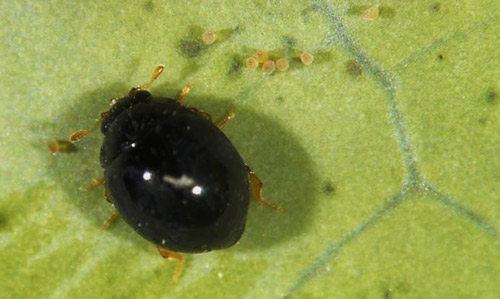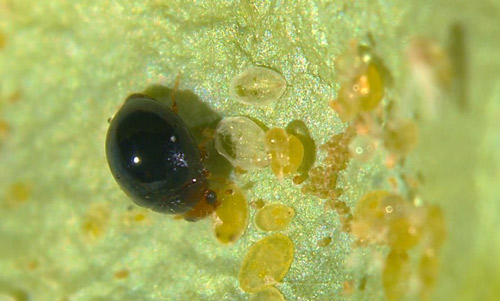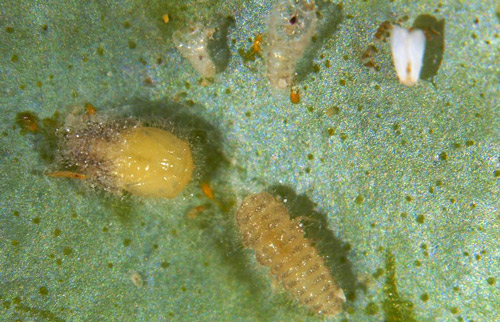common name: whitefly predatory lady beetle (suggested common name)
scientific name Delphastus catalinae (Horn) (Insecta: Coleoptera: Coccinellidae)
Introduction - Synonymy - Distribution - Description - Life Cycle and Behavior - Economic Importance - Selected References
Introduction (Back to Top)
Delphastus catalinae (Horn) is considered an effective biological control agent for whiteflies because of its high prey consumption rates, long adult survival, and high reproduction rates (Heinz et al. 1999). Delphastus catalinae has received research attention in Florida (and other states) for its value as a predator of the whitefly Bemisia tabaci (Gennadius) (Hemiptera: Aleyrodidae), which is an economically important pest of ornamental and agricultural crops (Razze et al. 2016a). There is a growing interest to increase knowledge and focus efforts on incorporating integrated pest management (IPM) strategies that are compatible with sustainable and organic production systems. Biological control has the potential to manage key pests in an integrated management program for whiteflies and other pests.
Figure 1. Adult female Delphastus catalinae (Horn) feeding on whitefly eggs. Photograph by Janine Razze, University of Florida.
Synonymy (Back to Top)
Delphastus catalinae was previously reported as Delphastus pusillus (LeConte, 1852). Gordon (1994) provided a revision of the genus Delphastus. Although there has been uncertainty as to the taxonomic status of the species of Delphastus spp. in commercial colonies, Hoelmer and Pickett (2003) concluded that species in commercial insectaries are likely Delphastus catalinae instead of Delphastus pusillus. They also concluded that most of the published studies of Delphastus pusillus predation on Bemisia tabaci actually described Delphastus catalinae.
Distribution (Back to Top)
Currently three species of Delphastus occur in Florida: catalinae (Horn), pallidus (LeConte), and pusillus (LeConte). Of the three species, Delphastus catalinae is the most commonly used member of this genus being commercially reared for controlling whiteflies. Delphastus catalinae is native to Colombia, South America. Currently, established populations can be found in tropical and subtropical regions in the United States, including California and Florida. Intentional releases have been made in Florida, Hawaii, and throughout the southwest region of the United States. Delphastus catalinae is commercially available for release throughout the United States and internationally.
Description (Back to Top)
Adults are minute, 1.4 mm long black beetles with yellow legs. Head coloration is used to distinguish females from males. Females have a black head (Figure 1), whereas males have an orange head (Figure 2). The larvae are elongated, cream-colored, covered with short fine hairs, and have visible legs, unlike a fly larva that has no legs (Figure 3). The pupae are more yellow and spherical (Figure 4).
Figure 2. Adult male Delphastus catalinae (Horn) feeding on whitefly nymphs. Photograph by Janine Razze, University of Florida.
Figure 3. Delphastus catalinae (Horn) larvae feeding on whitefly nymphs. Photograph by Janine Razze, University of Florida.
Figure 4. Delphastus catalinae (Horn) pupa (left) and late instar larva (right). Photograph by Janine Razze, University of Florida.
Life Cycle and Behavior (Back to Top)
The complete life cycle from egg to adult takes 21-25 days at 25-30°C (Hoelmer et al. 1993). Eggs are yellowish, oval, and laid in clusters on the underside of leaves. Females can deposit 200-300 eggs in their lifetime (Hoelmer et al. 1993). The larvae are capable of eating 1,000 whitefly eggs before they pupate. Older larvae migrate down the plant to pupate. Pupae are often found clustered along leaf veins on the underside of leaves. A single beetle can consume as many as 10,000 whitefly eggs at 160 per day, and up to 700 larvae during its lifetime (Hoelmer et al. 1993). Adult longevity is approximately 60 days for females and 45 days for males. Adults and larvae feed on whitefly eggs and immature stages. Eggs of Bemisia tabaci are preferred by Delphastus catalinae compared to nymphs. Delphastus catalinae will avoid parasitized nymphs (Hoelmer et al. 1994), and therefore is compatible with the use of parasitic wasps as biological control agents. If food is scarce, they will also feed on other small arthropods, such as spider mites and aphids (Legaspi et al. 2006). Delphastus spp. larvae have been observed feeding on honeydew and dew drops even when whiteflies were abundant. Availability of alternative food sources might allow Delphastus catalinae to survive periods of low prey density. While low temperatures are a limiting factor for Delphastus catalinae, small populations can survive mild winters where low temperatures are above 0°C. Humidity can also have an effect on Delphastus catalinae; low ambient moisture (10% relative humidity) was reported to have a negative impact on oviposition and survival (Simmons et al. 2008).
Economic Importance (Back to Top)
Delphastus spp. have been extensively studied as biological control agents for Dialeurodes citri (Ashmead), Aleurocanthus woglumi Ashby, Trialeurodes floridensis (Quaintance), Dialeurodes citrifolii (Morgan) (Hemiptera: Aleyrodidae), and Diaphorina citri Kuwayama (Hemiptera: Psyllidae) in citrus in Florida and for Bemisia tabaci in ornamentals and vegetable crops in Florida, California, and Texas. For a list of whitefly species attacked by Delphastus catalinae, see Table 1. Delphastus catalinae was first noted as a predator of Bemisia tabaci biotype B in central Florida during the late 1980s by L. S. Osborne (University of Florida). Greenhouse studies demonstrated that introductions of Delphastus catalinae on squash infested with Bemisia tabaci biotype B significantly reduced the whitefly populations. Augmentative releases of Delphastus catalinae can also be used in conjunction with bioinsecticides and intercropping with buckwheat to achieve significant reductions in whitefly populations on squash (Razze et al 2016b). Hoelmer and Pickett (2003) suggested a high degree of dispersal by Delphastus catalinae in the field. Therefore, ornamental and agricultural crops grown in the greenhouse might be better suited for whitefly control using Delphastus catalinae. It is recommended to release Delphastus in the greenhouse as soon as whiteflies are detected at a rate of 100 adults per whitefly “hot spot” or 10 adults per infested plant, with weekly releases for 3-4 weeks. Delphastus catalinae has been successfully mass reared and commercialized for whitefly management for many years. Their ability to quickly reduce high populations of whiteflies may be combined with parasitoids, including Encarsia and Eretmocerus spp. (Hymenoptera: Aphelinidae), and other compatible management strategies to further enhance whitefly management in field and greenhouse crops.
Table 1. Whitefly species attacked by Delphastus catalinae.
| Common name | Species | Host plant |
| Greenhouse whitefly | Trialeurodes vaporariorum | Wide variety of ornamental, fruit and vegetable crops (avocado, beans, cucumber, eggplant, melon, squash, tomato) |
| Bandedwinged whitefly | Trialeurodes abutiloneus | Ornamental plants including poinsettia, geranium, hibiscus, petunia |
| Silverleaf whitefly, Sweetpotato whitefly | Bemisia tabaci | Wide variety of ornamental, fruit and vegetable crops (tomato, peppers, squash, cucumber, beans, eggplant, watermelon, peanut, soybean, poinsettia, hibiscus, chrysanthemum) |
| Woolly whitefly | Aleurothrixus floccosus | Citrus, eugenia |
| Azalea and hibiscus whitefly | Pealius spp. | Azaleas, hibiscus |
| Cloudywinged, citrus and Rhododendron whitefly | Dialeurodes spp. | Citrus, rhododendrons |
| Citrus blackfly | Aleurocanthus woglumi | Citrus |
Selected References (Back to Top)
- Gordon RD. 1994. South American Coccinellidae (Coleoptera). Part III: Taxonomic revision of the western hemisphere genus Delphastus Casey. Frustula Entomologica 17: 71-133.
- Heinz KM, Brazzle JR, Parrella MP, Pickett CH. 1999. Field evaluations of augmentative releases of Delphastus catalinae (Horn) (Coleoptera: Coccinellidae) for suppression of Bemisia argentifolii Bellows and Perring (Homoptera: Aleyrodidae) infesting cotton. Biological Control 16: 241-251.
- Hoelmer KA, Osborne LS, Yokomi RK. 1993. Reproduction and feeding behavior of Delphastus pusillus (Coleoptera: Coccinellidae), a predator of Bemisia tabaci (Homoptera: Aleyrodidae). Journal of Economic Entomology 86: 322-329.
- Hoelmer KA, Osborne LS, Yokomi RK. 1994. Interactions of the whitefly predator Delphastus pusillus (Coleoptera: Coccinellidae) with parasitized sweetpotato whitefly (Homoptera: Aleyrodidae). Environmental Entomology 23: 136-139.
- Hoelmer KA, Pickett CH. 2003. Geographic origin and taxonomic history of Delphastus spp. (Coleoptera: Coccinellidae) in commercial culture. Biocontrol Science and Technology 13: 529-535.
- Legaspi JC, Simmons AM, Legaspi Jr BC. 2006. Prey preference by Delphastus catalinae (Coleoptera: Coccinellidae) on Bemisia argentifolii (Homoptera: Aleyrodidae): Effects of plant species and prey stages. Florida Entomologist 33: 218-222.
- Razze JM, Liburd OE, McSorley R. 2016a. Preference of the silverleaf whitefly, Bemisia tabaci B biotype, on zucchini squash and buckwheat and the effect of Delphastus catalinae on whitefly populations. Pest Management Science 72: 1335-1339.
- Razze JM, Liburd OE, Nuessly GS, Samuel-Foo M. 2016b. Evaluation of bioinsecticides for management of Bemisia tabaci (Hemiptera: Aleyrodidae) and the effect on the whitefly predator Delphastus catalinae (Coleoptera: Coccinellidae) in organic squash. Journal of Economic Entomology 109: 1766-1771.
- Simmons AM, Legaspi JC, Legaspi BC. 2008. Responses of Delphastus catalinae (Coleoptera: Coccinellidae), a predator of whiteflies (Hemiptera: Aleyrodidae), to relative humidity: Oviposition, hatch, and immature survival. Annals of the Entomological Society of America 101: 378-383.



